The Certification Process
A close examination of the IBM certification roles available quickly reveals that, in order to obtain a particular DB2 9 certification, you must take and pass one or more exams that have been designed specifically for that certification role. (Each exam is a software-based exam that is neither platform- nor product-specific.) Thus, once you have chosen the certification role you wish to pursue and familiarized yourself with the requirements for that particular role, the next step is to prepare for and take the appropriate certification exams.
Preparing for the Certification Exams
If you have experience using DB2 9 in the context of the certification role you have chosen, you may already possess the skills and knowledge needed to pass the exam(s) required for that role. However, if your experience with DB2 9 is limited (and even if it is not), you can prepare for any of the certification exams available by taking advantage of the following resources:
-
Formal Education
IBM Learning Services offers courses that are designed to help you prepare for DB2 9 certification. A listing of the courses that are recommended for each certification exam can be found using the Certification Navigator tool provided on IBM's "Professional Certification Program from IBM" Web site (www.ibm.com/certify). Recommended courses can also be found at IBM's "DB2 Data Management" Web site (www.ibm.com/software/data/education/learningcontent.html). For more information on course schedules, locations, and pricing, contact IBM Learning Services or visit their Web site.
-
Online Tutorials
IBM offers a series of seven interactive online tutorials designed to prepare you for the DB2 9 Fundamentals exam (Exam 730). These tutorials can be found at www-128.ibm.com/developerworks/offers/lp/db2cert/db2-cert730.html.
IBM also offers a series of interactive online tutorials designed to prepare you for the DB2 9 for Linux, UNIX, and Windows Database Administration exam (Exam 731) and the DB2 9 Family Application Development exam (Exam 733). These tutorials can be found at www-128.ibm.com/developerworks/offers/lp/db2cert/db2-cert731.html and www-128.ibm.com/developerworks/offers/lp/db2cert/db2-cert733.html.
-
Publications
All the information you need to pass any of the available certification exams can be found in the documentation that is provided with DB2 9. A complete set of manuals comes with the product and are accessible through the Information Center once you have installed the DB2 9 software. DB2 9 documentation can also be downloaded from IBM's Web site in both HTML and PDF formats. (The IBM Web site that contains the DB2 9 documentation can be found at www.ibm.com/software/data/db2/library.)
Self-study books (such as this one) that focus on one or more DB2 9 certification exams/roles are also available. Most of these books can be found at your local bookstore or ordered from many online book retailers. (A listing of possible reference materials for each certification exam can be found using the Certification Navigator tool provided on IBM's "Professional Certification Program from IBM" Web site (http://www.ibm.com/certify).
In addition to the DB2 9 product documentation, IBM often produces manuals, known as "RedBooks," that cover advanced DB2 9 topics (as well as other topics). These manuals are available as downloadable PDF files on IBM's RedBook Web site (www.redbooks.ibm.com). Or, if you prefer to have a bound hard copy, you can obtain one for a modest fee by following the appropriate links on the RedBook Web site. (There is no charge for the downloadable PDF files.)
A listing of possible reference materials for each certification exam can be found using the Certification Navigator tool provided on IBM's "Professional Certification Program from IBM" Web site (www.ibm.com/certify). Ordering information is often included with the listing.
-
Exam Objectives
Objectives that provide an overview of the basic topics that are covered on a particular certification exam can be found using the Certification Navigator tool provided on IBM's "Professional Certification Program from IBM" Web site (www.ibm.com/certify). Exam objectives for the DB2 9 Family Fundamentals exam (Exam 730) can also be found in Appendix A of this book.
-
Sample Questions/Exams
Sample questions and sample exams allow you to become familiar with the format and wording used on the actual certification exams. They can help you decide whether you possess the knowledge needed to pass a particular exam. Sample questions, along with descriptive answers, are provided at the end of every chapter in this book and in Appendix B. Sample exams for each DB2 9 certification role available can be found using the Certification Exam tool provided on IBM's "Professional Certification Program from IBM" Web site (www.ibm.com/software/data/education/cert/assessment.html). There is a $10 charge for each exam taken.
It is important to note that the certification exams are designed to be rigorous. Very specific answers are expected for most exam questions. Because of this, and because the range of material covered on a certification exam is usually broader than the knowledge base of many DB2 9 professionals, you should take advantage of the exam preparation resources available if you want to guarantee your success in obtaining the certification(s) you desire.
Arranging to Take a Certification Exam
When you are confident that you are ready to take a specific DB2 9 certification exam, your next step is to contact an IBM-authorized testing vendor. The DB2 9 certification exams are administered by Pearson VUE, by Thompson Prometric, and, in rare, cases by IBM (for example, IBM administers the DB2 9 certifications free of charge at some of the larger database conferences, such as the International DB2 User's Group North American conference). However, before you contact either testing vendor, you should visit their Web site (www.vue.com/ibm and www.2test.com, respectively) and use the navigation tools provided there to locate a testing center that is convenient for you to get to. Once you have located a testing center, you can then contact the vendor and make arrangements to take the certification exam. (Contact information for the testing vendors can also be found on their respective Web sites; in some cases, you can schedule an exam online.)
You must make arrangements to take a certification exam at least 24 hours in advance, and when you contact the testing vendor, you should be ready to provide the following information:
-
Your name (as you want it to appear on your certification certificate)
-
An identification number (if you have taken an IBM certification exam before, this is the number assigned to you at that time; if not, the testing vendor will supply one)
-
A telephone number where you can be reached
-
A fax number
-
The mailing address to which you want all certification correspondence, including your certification welcome package, to be sent
-
Your billing address, if it is different from your mailing address
-
Your email address
-
The number that identifies the exam you wish to take (for example, Exam 730)
-
The method of payment (credit card or check) you wish to use, along with any relevant payment information (such as credit card number and expiration date)
-
Your company's name (if applicable)
-
The testing center where you would like to take the certification exam
-
The date when you would like to take the certification exam
Before you make arrangements to take a certification exam, you should have pencil/pen and paper handy so you can write down the test applicant identification number the testing center will assign you. You will need this information when you arrive at the testing center to take the certification exam. (If time permits, you will be sent a letter of confirmation containing the number of the certification exam you have been scheduled to take, along with corresponding date, time, and location information; if you register within 48 hours of the scheduled testing date, you will not receive a letter).
| Tip | If you have already taken one or more of the certification exams offered, you should make the testing vendor aware of this and ask the vendor to assign you the same applicant identification number that was used before. This will allow the certification team at IBM to quickly recognize when you have met all the exam requirements for a particular certification role. (If you were assigned a unique applicant identification number each time you took an exam, you should go to the IBM Professional Certification Member Web site (www.ibm.com/certify/members) and select Member Services to combine all of your exam results under one ID.) |
With the exception of the DB2 9 for Linux, UNIX, and Windows Database Administration Upgrade Exam (Exam 736), each certification exam costs $150 (in the United States). Scheduling procedures vary according to how you choose to pay for the exam. If you decide to pay by credit card, you can make arrangements to take the exam immediately after providing the testing vendor with the appropriate information. However, if you elect to pay by check, you will be required to wait until the check has been received and payment has been confirmed before you will be allowed to make arrangements to take the exam. (Thompson Prometric recommends that if you pay by check, you write your registration ID on the front and contact them seven business days after the check is mailed. At that time, they should have received and confirmed your payment, and you should be able to make arrangements to take the exam you have paid for.)
If, for some reason, you need to reschedule or cancel your testing appointment after it is made, you must do so at least 24 hours before your scheduled test time. Otherwise, you will still be charged the price of the exam.
Taking an IBM Certification Exam
On the day you are scheduled to take a certification exam, you should arrive at the testing center at least 15 minutes before the scheduled start time to sign in. As part of the sign-in process, you will be asked to provide the applicant identification number you were assigned when you made arrangements to take the exam and two forms of identification. One form of identification must contain a recent photograph, and the other must contain your signature. Examples of valid forms of identification include a driver's license (photograph) and a credit card (signature).
Once you are signed in, the exam administrator will instruct you to enter the testing area and select an available workstation. The exam administrator will then enter your name and identification number into the workstation you have chosen, provide you with a pencil and some paper, and instruct you to begin the exam when you are ready. At that point, the title screen of the IBM Certification Exam testing software should be displayed on the computer monitor in front of you. Figure 1-8 illustrates what this screen looks like.

Figure 1-8: Title screen of the IBM Certification Exam testing software.
As you can see in Figure 1-8, the title screen of the IBM Certification Exam testing software consists of the IBM Certification Logo along with the title "Professional Certification Program from IBM," the name of the exam that is about to be administered, (for example, the title screen shown in Figure 1-8 indicates that the DB2 9 Family Fundamentals exam is about to be administered), and a welcome message containing your name and some basic information on how to get started. Before proceeding, you should:
-
Verify that the exam syou are about to take is indeed the exam you expected to take. If the name of the exam shown on the title screen is different from the name of the exam you had planned to take, bring this to the attention of the exam administrator immediately
-
Verify that your name is spelled correctly. The way your name appears in the welcome message shown on the title screen reflects how it has been stored in the IBM Certification database. This is how all correspondence to you will be addressed, and more importantly, this is how your name will appear on the certification credentials you will receive if you pass the exam you are about to take
In addition to telling you which exam is about to be administered, the title screen of the IBM Certification Exam testing software lets you know how many questions you can expect to see on the exam you are about to take, what kind of score you must receive in order to pass, and the time frame in which the exam must be completed. With one exception, each exam contains between 50 and 70 questions and is allotted 90 minutes for completion. The DB2 9 for Linux, UNIX, and Windows Database Administration Upgrade exam (Exam 736) contains 38 questions and is allotted 60 minutes for completion. Although each certification exam must be completed within a predefined time limit, you should never rush through an exam just because the "clock is running"; the time limits imposed are more than adequate for you to work through the exam at a relaxed, but steady pace.
When you are ready, begin by selecting the "Start" push button located in the lower left corner of the screen (refer to Figure 1-9). If instead you would like a quick refresher course on how to use the IBM Certification Exam testing software, select the "Help" push button located in the lower right corner of the screen. (If you panic and decide you're not ready to take the exam, you can select the "Exit" push button located between the "Start" and "Help" push buttons at the bottom of the screen to get out of the testing software altogether, but I recommend you talk with the exam administrator about your concerns before selecting this push button).
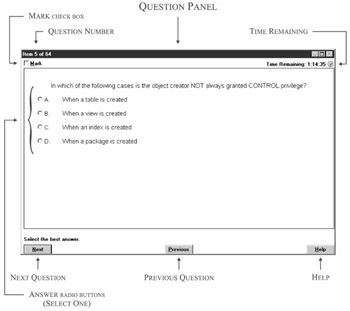
Figure 1-9: Typical question panel of the IBM Certification Exam testing software.
| Tip | If you plan to take a quick refresher course on how to use the IBM Certification Exam testing software, make sure you do so before you select the "Start" push button to begin the exam. Although help is available at any time, the clock does not start running until the "Start" push button is selected. By viewing help information before the clock is started, you avoid using what could prove to be valuable testing time reading documentation instead of test questions. |
Once the "Start" button on the title screen of the IBM Certification Exam testing software is selected, the clock will start running, and the first exam question will be presented in a question panel that looks something like the screen shown in Figure 1-9.
Aside from the question itself, one of the first things you may notice when you examine the question panel of the IBM Certification Exam testing software is the question number displayed in the top left corner of the screen. If you answer each question in the order they are presented, this portion of the screen can act as a progress indicator, because the current question number is displayed along with the total number of questions contained in the exam.
Immediately below the question number, you will find a special check box that is referred to as the "Mark" check box. If you would like to skip the current question for now and come back to it later, or if you're uncertain about the answer(s) you have chosen and would like to look at this question again after you have completed the rest of the exam, you should mark this check box (by placing the mouse pointer over it and pressing the left mouse button). When every question has been viewed once, you will be given the opportunity to review just the marked questions again. At that time, you can answer any unanswered questions remaining as well as re-evaluate any answers you provided about which you have some concerns.
Another important feature that can be found on the question panel is the "Time Remaining" information that is displayed in the top right corner of the screen. As the title implies, this area of the question panel provides continuous feedback on the amount of time you have available to finish and review the exam. If you would like to see more detailed information, such as the actual wall-clock time at which you began the exam and the time frame within which you are expected to complete the exam, you can view that information by selecting the clock icon located just to the right of the "Time Remaining" information. When this icon is selected (by placing the mouse pointer over it and pressing the left mouse button), a dialog similar to the one shown in Figure 1-10 is displayed.
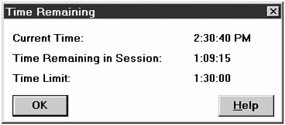
Figure 1-10: Time Remaining dialog.
Obviously, the most important part of the question panel is the exam question itself, along with the corresponding list of possible answers provided. Take the time to read each question carefully. When you have located the correct answer in the list provided, you should mark it by selecting the answer radio-button positioned just to the left of the answer text (by placing the mouse pointer over the desired answer radio-button and pressing the left mouse button). Once you have selected an answer for the question being displayed (or marked it with the "Mark" check box), you can move to the next question by selecting the "Next" push button, which is located in the lower left corner of the screen (refer to Figure 1-10).
If, at any time, you would like to return to the previous question, you can do so by pressing the "Previous" push button, located at the bottom of the screen, just to the right of the "Next" push button. Also, if you would like to access help on how to use the IBM Certification Exam testing software, you can do so by selecting the "Help" push button located in the lower right corner of the screen. It is important to note that, although the "Next" and "Previous" push buttons can be used to navigate through the questions provided with the exam, the navigation process itself is not cyclic in nature-that is, when you are on the first question, you cannot go to the last question by selecting the "Previous" push button (in fact the "Previous" push button will not be displayed if you are on the first question). Likewise, when you are on the last question, you cannot go to the first question simply by selecting the "Next" push button. However, there is a way to navigate quickly to a specific question from the item review panel, which we will look at shortly.
Although in most cases only one answer in the list provided is the correct answer to the question shown, there are times when multiple answers are valid. On those occasions, the answer radio-buttons will be replaced with answer check boxes, and the question will be worded in such a way that you will know how many answers are expected. An example of such a question can be seen in Figure 1-11.
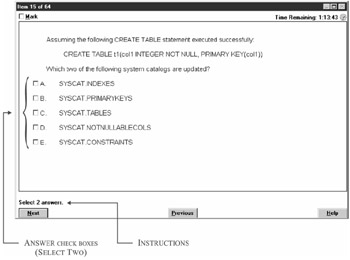
Figure 1-11: Question panel for questions expecting multiple answers.
These types of questions are answered by selecting the answer check box positioned just to the left of the text for every correct answer found. (Again, this is done by placing the mouse pointer over each desired answer check box and pressing the left mouse button.)
Once in a while, an illustration or the output from some diagnostic tool will accompany a question. You will be required to view that illustration or output (referred to as an exhibit) before you can successfully answer the question presented. On those occasions, a message instructing you to display the exhibit for the question will precede the actual test question, and a special push button called the "Exhibit" push button will be positioned at the bottom of the screen, between the "Previous" push button and the "Help" push button. An example of such a question can be seen in Figure 1-12.
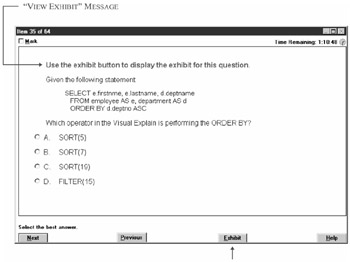
Figure 1-12: Question panel for questions that contain an exhibit.
To view the exhibit associated with such a question, you simply select the "Exhibit" push button located at the bottom of the screen. This action will cause the corresponding exhibit panel to be displayed. (A sample exhibit panel can be seen in Figure 1-13.)
Exhibit panels are relatively simple. In fact, once an exhibit panel is displayed, there are only two things you can do with it: You can close it by selecting the "Close" push button located at the bottom of the screen, or you can tile it (i.e., make it share screen real estate) with its corresponding question panel by selecting the "Tile" push button, which is located beside the "Close" push button. Aside from having to view the exhibit provided, the process used to answer questions that have exhibits is no different from the process used to answer questions that do not.
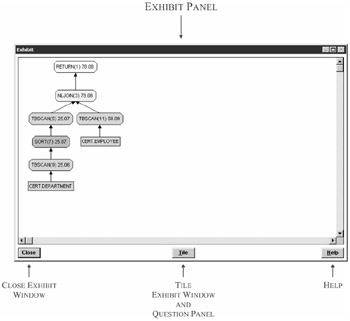
Figure 1-13: Sample exhibit panel.
When you have viewed every exam question available (by selecting the "Next" push button on every question panel shown), an item review panel that looks something like the panel shown in Figure 1-14 will be displayed.
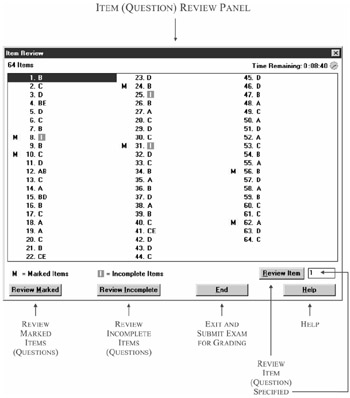
Figure 1-14: Item (question) review panel of the IBM Certification Exam testing software.
As you can see in Figure 1-14, the item review panel contains a numerical listing of the questions that make up the certification exam you are taking, along with the answers you have provided for each. Questions that you marked (by selecting the "Mark" check box) are preceded by the letter "M," and questions that you skipped or did not provide the correct number of answers for are assigned the answer "I" to indicate they are incomplete. By selecting the "Review Marked" push button located in the lower left corner of the screen (refer to Figure 1-15), you can quickly go back through just the questions that have been marked. When reviewing marked items in this manner, each time the "Next" push button is selected on a question panel, you are taken to the next marked question in the list until eventually you are returned to the item review panel. Likewise, by selecting the "Review Incomplete" push button located just to the right of the "Review Marked" push button, you can go back through just the questions that have been identified as being incomplete. (Navigation works the same as when the "Review Marked" push button is selected.) If, instead, you would like to review a specific question, you can do so by highlighting that question's number or typing that question's number in the entry field provided just to the right of the "Review Item" push button (which is located just above the "Help" push button in the lower right corner of the screen) and selecting the "Review Item" push button.

Figure 1-15: Item (question) review panel with all incomplete and marked items (questions) resolved.
| Tip | If you elect to use the "Review Item" push button to review a particular question, the only way you can return to the item review screen is by selecting the "Next" push button found on that question panel and every subsequent question panel presented until no more question panels exist. |
One of the first things you should do when the item review panel is displayed is resolve any incomplete items found. (When the exam is graded, each incomplete item found is marked incorrect, and points are deducted from your final score.) Then, if time permits, you should go back and review the questions that you marked. It is important to note that when you finish reviewing a marked question, you should unmark it (by placing the mouse pointer over the "Mark" check box and pressing the left mouse button) before going on to the next marked question or returning to the item review panel. This will make it easier for you to keep track of which questions have been reviewed and which have not.
As soon as every incomplete item found has been resolved, the "Review Incomplete" push button is automatically removed from the item review panel. Likewise, when there are no more marked questions, the "Review Marked" push button is removed from the item review panel. Thus, when every incomplete and marked item found has been resolved, the item review panel will look similar to the one shown in Figure 1-15.
Keep in mind that, even when the "Review Incomplete" and "Review Marked" push buttons are no longer available, you can still go back and review a specific question by highlighting that question's number or typing that question's number in the entry field provided and selecting the "Review Item" push button (refer to Figure 1-16).
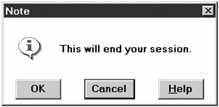
Figure 1-16: Confirmation dialog for end of exam session.
As soon as you feel comfortable with the answers you have provided, you can end the exam and submit it for grading by selecting the "End" push button, which should now be located in the lower left corner of the item review panel. When this push button is selected (by placing the mouse pointer over it and pressing the left mouse button), a dialog similar to the one shown in Figure 1-16 should be displayed.
If you select the "End" push button on the item review panel before every incomplete item found has been resolved, a dialog similar to the one shown in Figure 1-17 will be displayed instead.

Figure 1-17: Warning dialog for ending exam with incomplete items.
Both of these dialogs give you the opportunity to confirm your decision to end the exam and submit it for grading or to reconsider and continue resolving and/or reviewing exam questions. If you wish to do the former, you should select the "OK" or the "Yes" push button when one of these dialogs is presented; if you wish to do the latter, you should select the "Cancel" or "No" push button, in which case you will be returned to the item review panel. Keep in mind that if you select the "Yes" push button when the dialog shown in Figure 1-18 is displayed, all incomplete items found will be marked as being wrong, and this will have a negative impact on your final score.
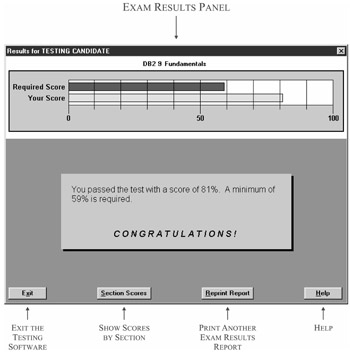
Figure 1-18: Exam results panel of the IBM Certification Exam testing software.
As soon as you confirm that you do indeed wish to end the exam, the IBM Certification Exam testing software will evaluate your answers and produce a score report that indicates whether or not you passed the exam. This report will then be displayed on an exam results panel that looks something like the panel shown in Figure 1-18, and a corresponding hard copy (printout) will be generated.
As you can see in Figure 1-19, the exam results panel shows the required score along with your actual score in a horizontal percent bar graph. Directly below this graph is a message that contains the percentage score you received, along with the percentage score needed to pass the exam. If you received a passing score, this message will end with the word "Congratulations!" However, if you received a score that is below the score needed to pass, the message you see will begin with the words "You did not pass the test," and your score will follow.
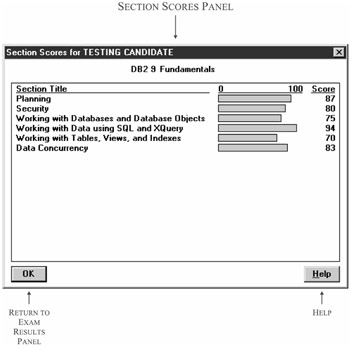
Figure 1-19: Section scores panel.
Each certification exam is broken into sections, and regardless of whether you pass or fail, you should take a few moments to review the score you received for each section. This information can help you evaluate your strengths and weaknesses; if you failed to pass the exam, it can help you identify the areas you should spend some time reviewing before you attempt to take the exam again. To view the section scores for the exam you have just completed, you simply select the "Section Scores" push button located at the bottom of the screen. This action will cause a section scores panel similar to the one shown in Figure 1-19 to be displayed.
When you have finished reviewing your section scores, you may return to the exam results panel by selecting the "OK" push button located at the bottom left corner of the screen. From there, you can exit the IBM Certification Exam testing software by selecting the "Exit" push button, which is also located at the bottom left corner of the screen.
Shortly after you take a certification exam (usually within five working days), the testing vendor sends your results, along with your demographic data (e.g., name, address, phone number) to the IBM Certification Group for processing. If you passed the exam, you will receive credit toward the certification role the exam was designed for, and if the exam you took completes the requirements that have been outlined for a particular certification role, you will receive an email (at the email address you provided during registration) that contains a copy of the IBM Certification Agreement and a welcome package that includes a certificate that is suitable for framing (as a .PDF file), camera-ready artwork of the IBM certification logo, and guidelines for using the "IBM Certified" mark. (If this email cannot be delivered, the welcome package will be sent to you via regular mail.) You can also receive a printed certificate, along with a wallet-sized certificate, via regular mail by going to the Web site referenced in the email you receive and asking for it-you will be asked to provide your Fulfillment ID and Validation Number (also provided in the email) as verification that you have met the requirements for certification.
Upon receipt of the welcome package, you will become certified, and you can begin using the IBM Professional Certification title and trademark. (You should receive the IBM Certification Agreement and welcome package within four to six weeks after IBM processes the exam results.) However, if you failed to pass the exam and you still wish to become DB2 9 certified, you must make arrangements to take it again (including paying the testing fee again). There are no restrictions on the number of times you can take a particular certification exam; however, you cannot take the same certification exam more than two times within a 30-day period.
EAN: 2147483647
Pages: 93